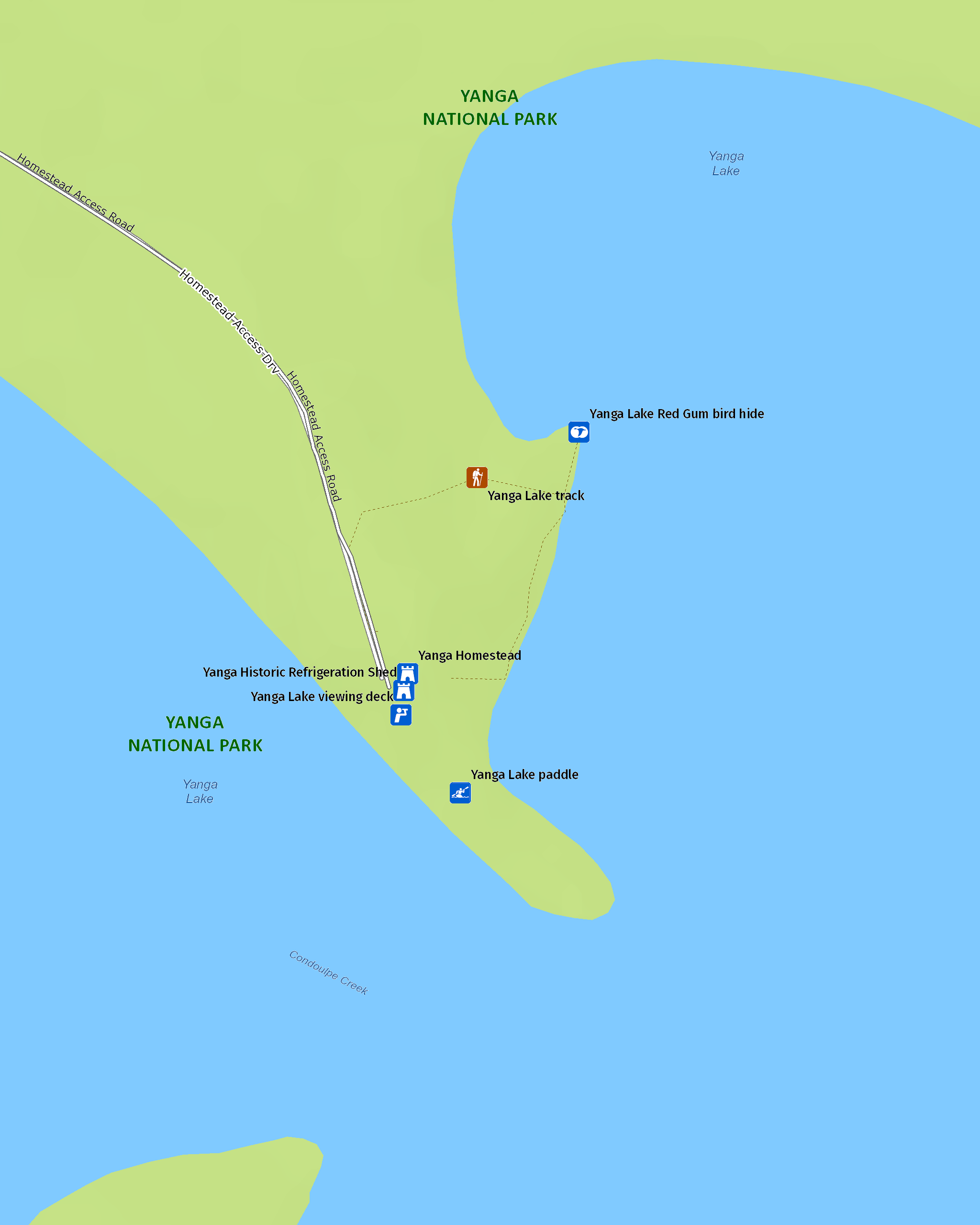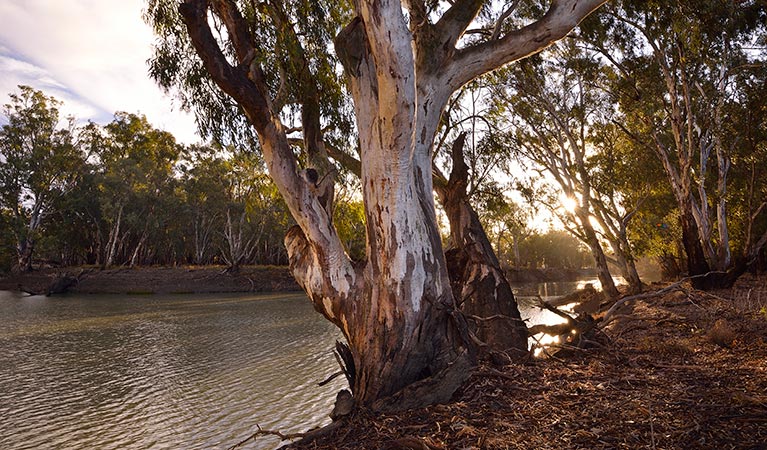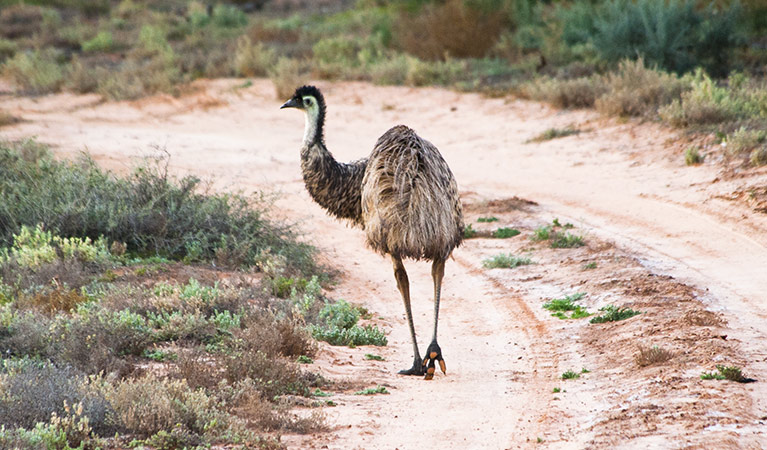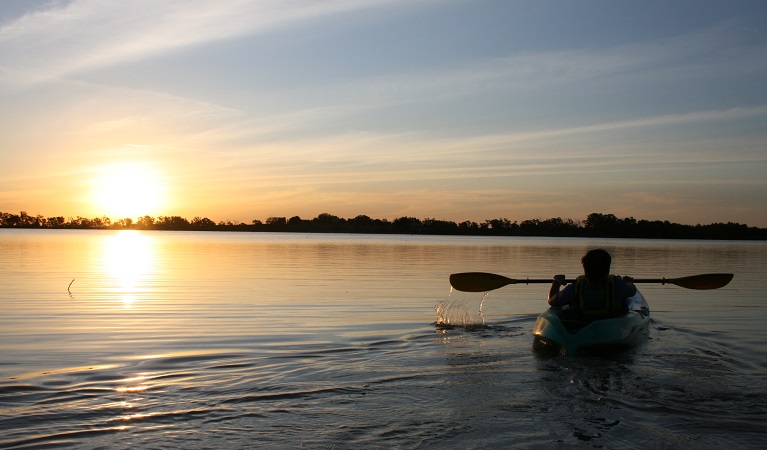Overview
Kayak Yanga Lake for an outback experience like no other. Wonder at the vast sky reflected in 1200ha of water, and spot wildlife and birds drawn to the wetlands in Yanga National Park.
- Where
- Yanga National Park in Murray-Riverina
- Accessibility
- No wheelchair access
- Time suggested
- 3 - 6 hr
- Grade
- Medium. All participants must be able to swim. Moderate level of fitness required.
- What to
bring - Drinking water, sunscreen, hat
- Please note
Yanga Lake is a reasonably isolated area, so it’s a good idea to bring all supplies for your vehicle and your group.
If you’re visiting Yanga Woolshed and Yanga Homestead, near Balranald, make time to go kayaking on Yanga Lake as well. It’s a great activity for people of all ages, from bird watchers and photographers, to paddling enthusiasts and active families.
Glide through the calm waters under the vast outback sky, surrounded by rows of ancient river red gum eucalypts. The sense of freedom and tranquillity is unforgettable, and inspires a deep connection with the natural landscape.
Birdwatchers will relish spotting a whole cast of water birds. Autumn and spring – the birds’ breeding season – are the best times to paddle, but through the year you can see black and whistling kites, wedge-tailed eagles and white-bellied sea eagles, cormorants and egrets. By the shore, there’s bound to be emus, kangaroos and a goanna or two.
Nearby
-

Yanga Lake viewing deck
Yanga Lake viewing deck offers spectacular birdwatching and scenic wetland views in Yanga National Park, near Balranald.
-

Yanga Lake walking track
Short yet rewarding, Yanga Lake walking track is a family friendly lakeside walk offering scenic wetlands views and spectacular birdwatching in Yanga National Park.
-

The Willows campground and picnic area
The Willows campground in Yanga State Conservation Area has tent, trailer and caravan campsites with picnic tables and barbecues. Great fishing and birdwatching awaits.
Map

Map legend

Local alerts
For the latest updates on fires, closures and other alerts in this area, see https://www.nationalparks.nsw.gov.au/things-to-do/canoeing-paddling-experiences/yanga-lake-paddle/local-alerts
Park info
- in Yanga National Park in the Murray-Riverina region
Yanga National Park is open Sunrise to Sunset but may have to close at times due to poor weather or fire danger.
Yanga Homestead Precinct is open 8.30am - 4.30pm.
Visitor info
All the practical information you need to know about Yanga Lake paddle.
Getting there and parking
Yanga National Park office is at Yanga Homestead. To get there:
- From Balranald, take the Sturt Highway east for 7km
- Turn south onto Old Sturt Highway at Yanga rest area
- Turn left at the Yanga National Park sign and drive 2km along the main road where you will arrive at the park office and Yanga Homestead
Road quality
- Mixture of sealed and unsealed roads
Vehicle access
- 2WD vehicles
Weather restrictions
- All weather
Parking
Parking available at Yanga Homestead, a short walk from the kayak launching area
Facilities
Toilet facilities, picnic tables and carpark available at Yanga Homestead
Maps and downloads
Accessibility
Disability access level - no wheelchair access
- This activity is not wheelchair-accessible
- Yanga Lake viewing deck, Yanga Homestead and gardens are wheelchair-accessible.
Permitted
Fishing
A current NSW recreational fishing licence is required when fishing in all waters.
Learn more
Yanga Lake paddle is in Yanga National Park. Here are just some of the reasons why this park is special:
A pioneering history

Some of the country's renowned early explorers passed through this area, and you have the opportunity to retrace their steps. Explorers included John Oxley in 1817, Charles Sturt in 1830, Major Thomas Mitchell in 1836 and Burke and Wills in 1860. Visit nearby Balranald to see where Bourke and Wills' party crossed the Murrumbidgee by the Mayall Street punt, then camped by the river in front of Balranald Inn.
- Yanga Woolshed Explore Yanga Woolshed in Yanga National Park. When constructed in the late 1800s, the woolshed was the Riverina’s largest. It offers an insight into Australia’s pastoral history.
- Yanga Woolshed picnic area Located in Yanga National Park, near Balranald in the Riverina, Yanga Woolshed picnic area is an excellent place for a barbecue or spot of fishing on the Murrumbidgee.
A remarkable landscape

Yanga National Park is blessed with 170km of Murrumbidgee River frontage. The river is great for canoeing or swimming, and its banks provide excellent fishing and camping spots. On your visit, you'll notice the landscape's unique contrast of black and red country. Vegetation on its black soil floodplains comprises river red gum forest and swampland, while its red soil varies from grass to saltbush to woodlands. Come and spot the differences yourself.
- Regatta Beach picnic area Enjoy swimming, boating, birdwatching and paddling in the tranquil lakeside waters of picturesque Regatta Beach picnic area in Yanga National Park, near Balranald.
Rich in Aboriginal culture

Yanga National Park has a rich Aboriginal history; the park provided resources including waterbirds, fish, and yabbies as well as shelter and medicine. Look closely at the trees in the floodplain where you're visiting – many bear the bark-stripping scars from canoe-making. Today, local Aboriginal people remain connected with Yanga National Park through employment or community involvement.
- Yanga Lake viewing deck Yanga Lake viewing deck offers spectacular birdwatching and scenic wetland views in Yanga National Park, near Balranald.
Unbeatable for birdwatchers

A large number of migratory birds rely on the Yanga National Park red gum wetlands. The park is a great place to see egrets, herons, spoonbills and glossy ibis using the wetlands as a resting, foraging and breeding ground. Walk to the bird hide at Yanga Lake to see great crested grebes and sea eagles. The park is also home to the endangered southern bell frog. This frog's calls' are said to resemble a distant motorbike – listen carefully to see if you can hear it.
- Yanga Lake paddle Kayak Yanga Lake for an outback experience like no other. Wonder at the vast sky reflected in 1200ha of water, and spot wildlife and birds drawn to the wetlands in Yanga National Park.
- Yanga Lake Red Gum bird hide All the family will enjoy spectacular birdwatching and scenic views at Yanga Lake Red Gum bird hide in Yanga National Park near Balranald.
- Yanga Lake walking track Short yet rewarding, Yanga Lake walking track is a family friendly lakeside walk offering scenic wetlands views and spectacular birdwatching in Yanga National Park.
Plants and animals protected in this park
Animals
-

Southern boobook (Ninox novaeseelandiae)
The southern boobook, also known as the mopoke, is the smallest and most common native owl in Australia. With a musical 'boo-book' call that echoes through forests and woodlands, the southern boobook is a great one to look out for while bird watching.
-

Common ringtail possum (Pseudocheirus peregrinus)
Commonly found in forests, woodlands and leafy gardens across eastern NSW, the Australian ringtail possum is a tree-dwelling marsupial. With a powerful tail perfectly adapted to grasp objects, it forages in trees for eucalypt leaves, flowers and fruit.
-

Kookaburra (Dacelo novaeguineae)
Of the 2 species of kookaburra found in Australia, the laughing kookaburra is the best-known and the largest of the native kingfishers. With its distinctive riotous call, the laughing kookaburra is commonly heard in open woodlands and forests throughout NSW national parks, making these ideal spots for bird watching.
Plants
-

River red gum (Eucalpytus camaldulensis)
Australian native plants, majestic river red gum trees are widespread across Australian inland river systems. The river red gum is a dominant tree species of the Murray-Darling basin which spans NSW, Queensland and Victoria. This iconic native eucalypt grows to a height of 30m and is thought to have a lifespan up to 500-1000 years.
-

Saltbush (Atriplex nummularia)
A hardy Australian native plant, the saltbush is a small spreading shrub that can withstand dry salty soils such as those found in the desert plains of western NSW. It is grey-white in colour and has small spear-shaped succulent leaves. It flowers from December to April.

